SECURITISATION AND RECONSTRUCTION OF FINANCIAL ASSETS AND ENFORCEMENT OF SECURITY INTEREST ACT, 2002
The Sarfaesi Act, 2002 basically was designed to protect the interests of the bank as a creditor. This act provides to protect only secured creditors. This is a powerful tool in the hands of the bank for recovering non-performing assets (NPA). This is only possible when these assets are backed by securities i.e. where the bank is able to enforce underlying securities. A non-performing asset is an obligation relating to debt where the lender is not being paid the agreed principal or interest repayment instalments or the lump sum amount as the case may be, by the borrower for an extended period of time. Usually the debt becomes non-performing when the payments due are not made within 90 days. So, in a way we can say that time limit of 90 days from the date of acquisition is a standard time period for repayment of loan principal amount as well as interests. Banks generally classify the loan as non-performing after 90 days of non-payment. However this time period can be longer or shorter than 90 days as agreed before in terms and conditions.
This act empowers the banks either to seize the securities kept with it in case of non-payment without the intervention of the court or the bank can use the alternative option of selling the securities to ARCs (Asset Reconstruction Company) that are regulated by the RBI. RBI has issued full-fledged guidelines on the process that a bank is required to follow while selling the securities to the ARCs.
The bank may give a notice to the borrower asking him to discharge his debt within 60 days and if borrowers fail to do so, the bank can sell or lease the security, take possession of the security or manage the security itself. It can even appoint a person to manage it.
CAUSE OF ACTION
The creditor can exercise his rights under this act only if:
a. The debt is a secured debt i.e. is backed by securities. In case the borrower refuses to pay, the bank can take charge of the securities;
b. Bank classifies the debt as non-performing;
c. More than 20% of principal loan and interest amount and one lakh rupees and above are outstanding dues;
d. Agricultural land is not the security to be enforced.
Bank as plaintiff in court
If the issue is regarding an unsecured asset, the bank will have to move to court by filing a civil suit.
This act has made provisions for recovering NPA assets by two main methods:
a. Securitisation
b. Asset reconstruction
The SARFAESI Act is not applicable in certain cases mentioned below:
a. It cannot be enforced in Jammu and Kashmir;
b. The security is fraudulent or unsecured;
c. A lien given by or under the Indian Contract Act,1872 or the Sale of Goods Act,1930 or any other law in force for that period on goods, money or security;
d. Movable property’s pledge under section 172 of the Indian Contract Act,1872;
e. When any security has been created in any aircraft as defined in clause(1) of Section 2 of the Aircraft Act, 1934;
f. creation of security interest in any vessel as defined in clause (55) of Section 3 of the Merchant Shipping Act, 1958;
g. where no security interest is being created in any conditional sale, hire-purchase, lease or other contract;
h. unpaid seller’s rights under Section 47 of the Sale of Goods Act, 1930;
i. any properties which are not liable to attachment or sale under Section 60 of the Code of Civil Procedure, 1908;
j. for securing repayment of any financial assets, the security interest is below one lakh rupees;
k. the case in which the amount due is less than 20% of the principal and interest amount.
Constitutional Validity
The Supreme Court upheld the constitutional validity of the SARFAESI ACT, 2002 in Mardia Chemicals ltd v. Union of India.
TO BE COMPLETED









